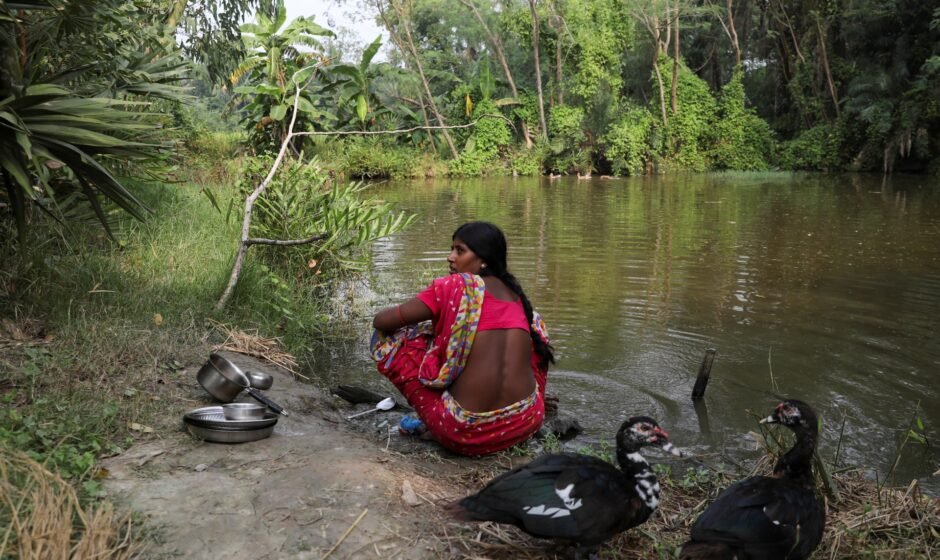Panchanan Dolui, a resident of Mousuni Island in the Indian Sundarbans, has been forced to move his home three times due to floods and river erosion. Each time, he has had to relocate farther away from the receding edge of the island to avoid displacement. Dolui has witnessed vast tracts of land being eaten away by the river, leaving him and others with nowhere else to go.
The Sundarbans forest system, located in West Bengal state in eastern India and neighboring Bangladesh, is a collection of low-lying islands and is the largest mangrove ecosystem in the world. It is not only home to several endangered species but also acts as a natural barrier against cyclones, storm surges, and other environmental hazards. Additionally, the forests play a crucial role in carbon capture and sequestration.
However, the Sundarbans are facing rapid changes. The occurrence of four cyclones – Fani, Amphan, Bulbul, and Yaas – from 2019 to 2021 highlights the increasingly unpredictable weather in the region, which is caused by climate change and rising sea levels. As a result, the Sundarbans are becoming increasingly unsafe for human habitation, according to Kalyan Rudra, chairperson of the West Bengal Pollution Control Board.
The recent cyclones have compounded the climate-induced displacement that the people of the Sundarbans have been experiencing for decades. Lohachara, one of the first inhabited islands in the region, disappeared under the sea in 1996, forcing residents to relocate to neighboring islands without proper documentation or property deeds. Migration has become a coping strategy for many residents, but the lack of development in the region and limited livelihood options make it a challenging solution.
One of the significant challenges faced by the Sundarbans is increased salinity, which affects farming and soil productivity. Salinity-resistant paddy farming has become popular as a climate change adaptation measure, but it has also led to commercial-scale brackish water shrimp farming, causing land degradation. The health of women involved in prawn seed collection, which requires standing in saltwater for up to six hours, is adversely affected by the increasing salinity. Moreover, the severely degraded mangrove ecosystem due to salinity has led to a loss of forest reserves that sustain local communities and has negatively impacted biodiversity.
Another issue in the Sundarbans is the conflict between humans and animals, particularly tigers. The Sundarbans are home to tiger widows, whose husbands were killed by tigers while fishing or collecting honey in the reserve. These deaths are often not officially recognized, as entry into the forest is illegal for residents since it became a tiger reserve. The process of applying for compensation for tiger deaths is complicated and bureaucratic, requiring a police report and death certificate. However, a recent decision by the Calcutta High Court acknowledged tiger deaths and ordered compensation for two tiger widows.
The marginalization of vulnerable communities, based on factors such as caste and gender, is exacerbated by ongoing climate disasters. Government relief efforts after disasters are often selective and contingent on existing land holdings, leaving many vulnerable residents without sufficient support. The erosion of the Sundarbans shoreline also poses challenges for relocation efforts, as prime land is already occupied, and relocating marginalized and vulnerable communities to another edge is not a sustainable solution.
The future of climate resilience in the Sundarbans remains uncertain. While the National Disaster Management Authority has developed a draft policy to address coastal and river erosion and the resettlement of displaced communities, the allocation and disbursement of funds are subject to political influences. The contentious relationship between the central and West Bengal governments further complicates the situation.
In December, Kolkata, the state capital, became one of the first claimants for climate change-induced loss and damage from the Loss and Damage Fund agreed upon during the United Nations COP28 summit. The fund aims to provide coverage for climate-displaced populations from the Sundarbans. However, the effectiveness of such initiatives relies on political will and cooperation.
In conclusion, the Sundarbans face significant challenges due to climate change, rising sea levels, and human activities. Displacement, land degradation, health issues, and conflicts with wildlife are among the many issues affecting the region. The future of the Sundarbans and its millions of inhabitants hangs in the balance, requiring sustainable solutions, political will, and international cooperation.




